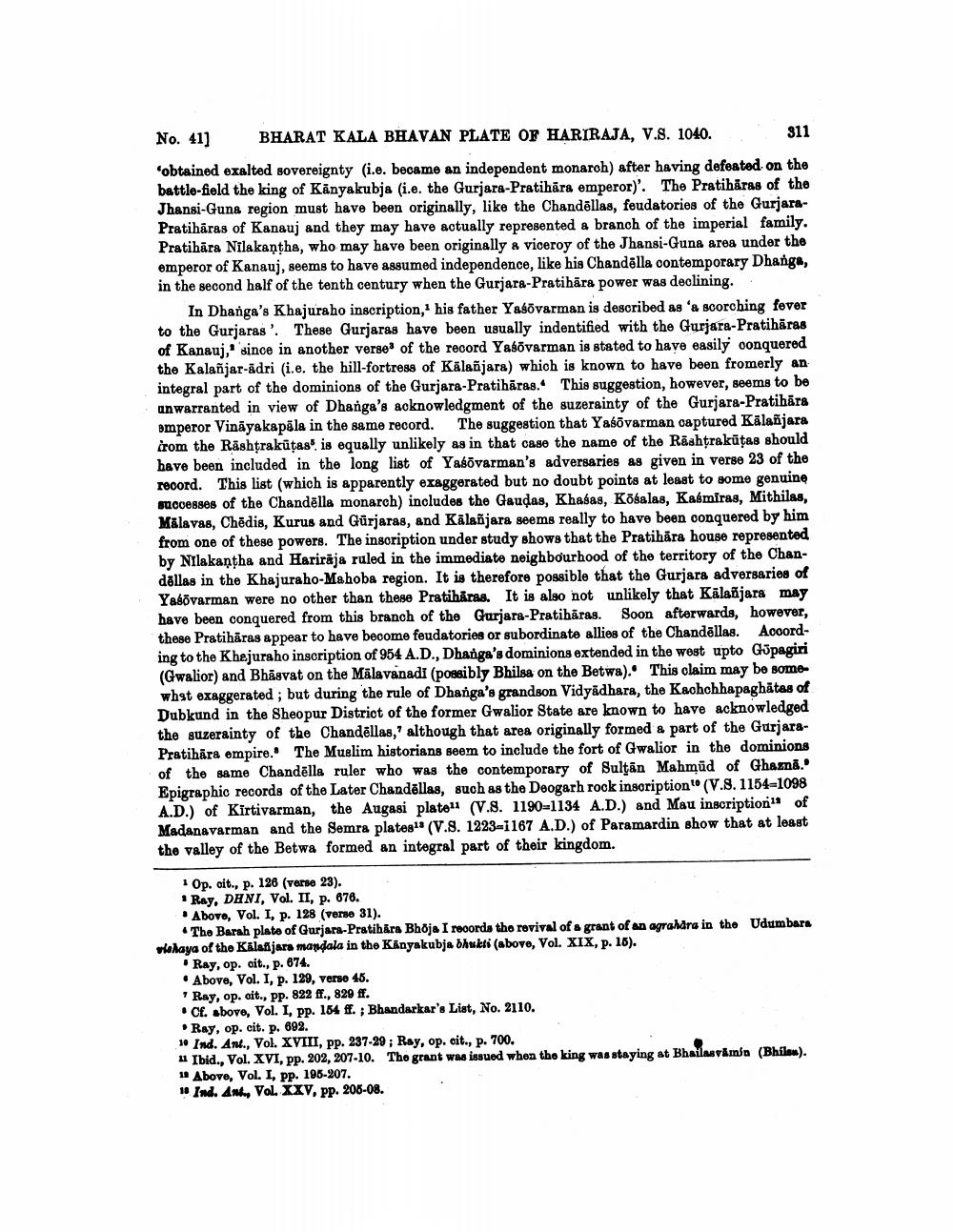________________
No. 41) BHARAT KALA BHAVAN PLATE OF HARIRAJA, V.S. 1040. 311
obtained exalted sovereignty (i.e. became an independent monarch) after having defeated on the battle-field the king of Kanyakubja (i.e. the Gurjara-Pratihāra emperor)'. The Pratihāras of the Jhansi-Guna region must have been originally, like the Chandēllas, feudatories of the GurjaraPratihāras of Kanauj and they may have actually represented a branch of the imperial family. Pratihāra Nilakantha, who may have been originally a viceroy of the Jhansi-Guna area under the emperor of Kanauj, seems to have assumed independence, like his Chandēlla contemporary Dhange, in the second half of the tenth century when the Gurjara-Pratibära power was declining.
In Dhanga's Khajuraho inscription, his father Yasovarman is described as “a scorching fover to the Gurjaras'. These Gurjaras have been usually indentified with the Gurjara-Pratihāras of Kanauj, since in another verse of the record Yasovarman is stated to have easily conquered the Kalañjar-ādri (i.e. the hill-fortress of Kālaõjara) which is known to have been fromerly an. integral part of the dominions of the Gurjara-Pratihāras. This suggestion, however, seems to be anwarranted in view of Dhanga's acknowledgment of the suzerainty of the Gurjara-Pratibārs emperor Vināyakapāla in the same record. The suggestion that Yasovarman captured Kālañjara èrom the Rashtrakūtas, is equally unlikely as in that case the name of the Rashtrakūtas should have been included in the long list of Yasovarman's adversaries as given in verse 23 of the record. This list (which is apparently exaggerated but no doubt points at least to some genuine BUCOesses of the Chandēlla monarch) includes the Gaudas, Khasas, Kõsalas, Kasmiras, Mithilas, Malavas, Chēdis, Kurus and Gürjaras, and Kālañjara seems really to have been conquered by him from one of these powers. The insoription under study shows that the Pratihära house represented by Nilakantha and Hariraja ruled in the immediate neighbourhood of the territory of the Chandallas in the Khajuraho-Mahoba region. It is therefore possible that the Gurjara adversaries of Yabövarman were no other than these Pratihåras. It is also not unlikely that Kālañjara may have been conquered from this branch of the Gurjara-Pratihāras. Soon afterwards, however, these Pratibāras appear to have become feudatories or subordinate allies of the Chandallas. Acoording to the Khajuraho inscription of 954 A.D., Dhanga's dominions extended in the west upto G3pagiri (Gwalior) and Bhasvat on the Malavanadi (possibly Bhilsa on the Betws). This claim may be some what exaggerated; but during the rule of Dhanga's grandson Vidyadhara, the Kachchhapaghātas of Dubkund in the Sheopur District of the former Gwalior State are known to have acknowledged the suzerainty of the Chandellas, although that area originally formed a part of the GurjaraPratihāra empire. The Muslim historians seem to include the fort of Gwalior in the dominions of the same Chandēlla ruler who was the contemporary of Sultān Mahmud of Ghaznā.' Epigraphic records of the Later Chandēllas, such as the Deogarh rook insoription(V.8. 1154-1098 A.D.) of Kirtivarman, the Augasi platalı (V.8. 1190-1134 A.D.) and Mau inscription of Madanavarman and the Semra platest (V.8. 1223-1167 A.D.) of Paramardin show that at least the valley of the Betwa formed an integral part of their kingdom.
Op. cit., p. 126 (verse 23). * Ray, DHNI, Vol. II, p. 676. . Abovo, Vol. I, p. 128 (verso 31).
The Barah plate of Gurjara-Pratihara Bhoja I records tho revival of a grant of an agrahara in the Udumbara vhalaya of the Kalajara mandala in the Kanyakubja bhukti (abovo, Vol. XIX, p. 16).
Ray, op. cit., p. 674. • Above, Vol. I, p. 129, verso 45.
Ray, op. cit., pp. 822 ff., 829 ff. . Cf. abovo, Vol. I, pp. 164 ff.; Bhandarkar's List, No. 2110.
Ray, op. cit. p. 692. 1. Ind. Ant., Vol. XVIII, pp. 237-29; Ray, op. cit., p. 700. u Ibid., Vol. XVI, pp. 202, 207-10. Tho grant was issued when the king was staying at Bhailasvimin (Bhílau). 11 Above, Vol. I, pp. 195-207. 1. MA Vol XP, PP. 208-04.




